Sins of the Father: Syrian President Hafez Assad’s Legacy of Chemical Weapons and the Balance of Power in the Middle East
Only three weeks ago the world media was filled with horrific images of Syria’s purported use of chemical weapons and the military response of America and its allies. But we’ve been here before which raises the question: why does this keep happening?
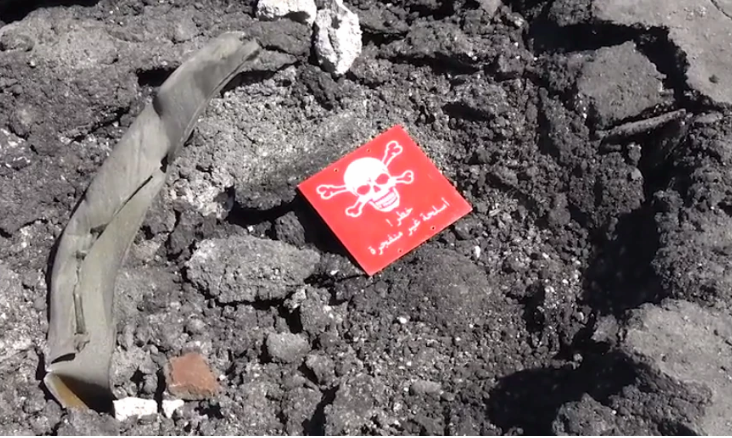
Readex’s Nuclear Arms and Weapons of Mass Destruction: Global Perspectives, 1945-1996, contains abundant references to the development of Syrian chemical weapons as a readily attainable foil to Israel’s alleged nuclear capability, and as an impediment to American hegemony in the Middle East. In that region, chemical weapons have become the less-developed country’s nuclear arms, with most of the benefits and few of the liabilities of the latter.
The late Syrian President Hafez Assad, father of current President Bashar Assad, said as much in a 1987 interview in the newspaper Al-Qabas, as broadcast on the Damascus Domestic Service, recorded and translated by the Central Intelligence Agency’s Foreign Broadcast Information Service (FBIS), and now found in Nuclear Arms and Weapons of Mass Destruction. Assad spoke of a “taboo” against the use of nuclear weapons that he used to Syria’s advantage:
Even if Israel possesses the atomic bomb we must not think that its use is easy. The United States, which possesses the atomic bomb, fought for many years in Vietnam, sustained heavy losses, and was defeated by the Vietnamese, who do not possess the atomic bomb. The United States, although it was defeated, was not able to use the atomic bomb against the Vietnamese. ....
There are conditions for the use of the atomic bomb. In my opinion, these conditions are more difficult for Israel than for the United States. They are difficult in terms of technology and geographic location.
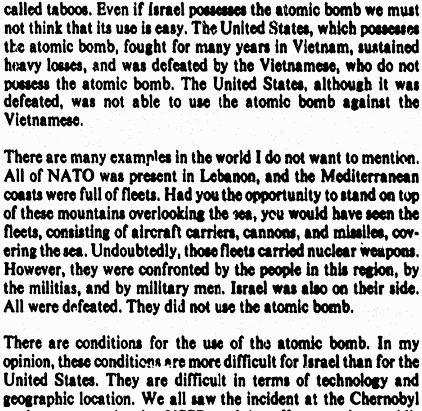
Assad managed to use Israel’s possession of nuclear weapons to justify Syria’s development of its own weapons of mass destruction (WMDs), while asserting that a host of factors prevented Israel or even the United States from using their own nuclear capability in any realistic way. In this intemperate middle ground of strategic escalation, Syria could pursue its own WMD programs with impunity, secure in the knowledge that it is unlikely to face anything other than conventional weapons on the battlefield.
Assad was consistent in applying this approach to countering Israeli and American military superiority. As early as 1986 in the newspaper Ha’aretz, Israeli Prime Minister Shimon Peres confirmed the existence of a Syrian chemical weapons program:
In his speech before the National Defense College last week, Prime Minister Shim’on Peres exposed a silent conspiracy regarding a protracted Syrian effort to produce chemical weapons. It was the first time that an Israeli leader had confirmed that the Syrians are already at an advanced stage of mounting chemical warheads (apparently nerve gas) on their surface-to-surface missiles.

The Ha'aretz author goes on to offer a rationale for Syria’s focus on chemical weapons:
It is becoming increasingly evident that even before the Middle East enters the nuclear arms era it will enter the chemical, and then the biological weapons era. It is easier to operate in the latter than in the nuclear sphere. Chemical technologies can be obtained indirectly claiming the pretext of a different use. Biological technologies are not considered beyond reach. The technological difficulties involved in producing these weapons systems are not at all similar to those involved in producing nuclear arms....
Some say that the chemical weapons the Arabs have begun to deal with is a sort of Arab response to the nuclear arms they claim Israel possesses. It was along these lines that a former Syrian officer depicted a war scenario in an article published in an Arabic paper issued in London. This, in fact, is the Arab excuse for producing chemical weapons.
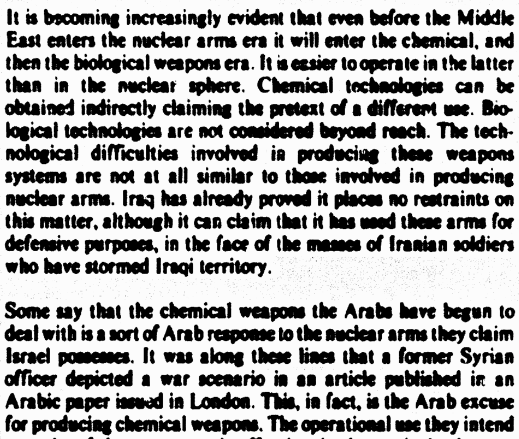
In the fall of 1986 the London Sunday Telegraph also reported on Syria’s chemical weapon program, and pointed to Libya as the source of that capability:
Colonel al-Qadhdhafi of Libya has acquired a lethal nerve gas warhead for his force of Scud-B missiles, giving his Arab allies the capability to launch devastating strikes on Israeli cities.
Highly placed Western intelligence sources say that the warheads contain a lethal “non-persistent nerve agent” and have been passed on by the regime within the last few weeks to Syria and Iran, both of which operate identical Scud-B systems.
The Scud-B chemical warheads could kill every human within an area of 25 square miles and render a city uninhabitable for about 24 hours after the attack, depending on weather conditions.
Libya is too far from Israel for Colonel al-Qadhdhafi to use his Scud missiles against Israel. Military experts, however, see the possession by Syria of a chemical warhead for its Scud as “potentially the most dangerous military development in the Middle East in the last 20 years.”
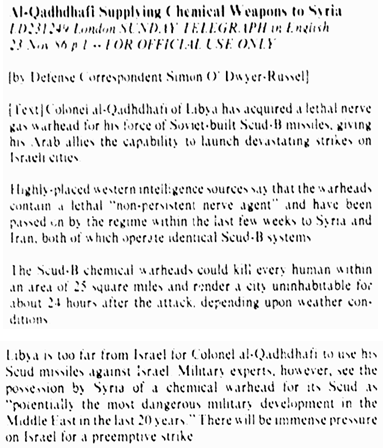
Israel saw to it that the U.S. was apprised of the Syrian development, and used that as an occasion to solicit America‘s assistance. Note that the office of the Prime Minister had changed hands from the Zionist Labor Party to the center-right Likud Party:
Prime Minister Yitzhaq Shamir has for the first time confirmed that Syria has chemical weapons. In a meeting with U.S. Senator Daniel Inouye in Jerusalem yesterday, Shamir said, “Syria is arming itself with modern chemical weapons.” According to the Prime Minister, Israel must keep alert and the IDF must be prepared to prevent any surprises. “This calls for a vast financial effort, and U.S. assistance on this issue is vital,” Shamir said.
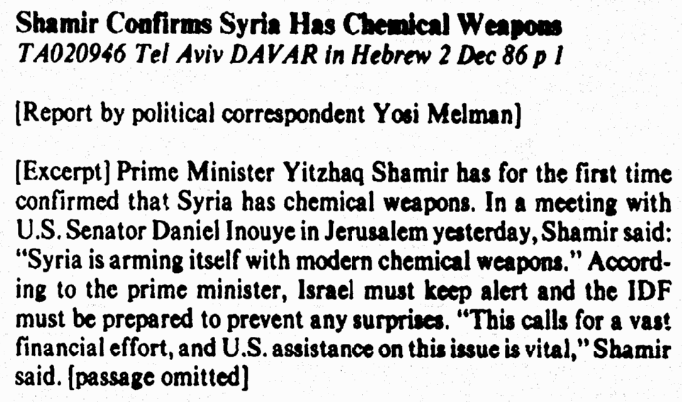
Even as late as 1988 when the Soviet Union was on the verge of dissolution, the Russians were also very interested in fostering Syria’s new capability.
The Soviet Army’s chief of chemical warfare paid a secret visit to Syria to examine cooperation between the two countries in the field of chemical weapons. This has been learned by Nisim Mish’al, our correspondent in Washington.
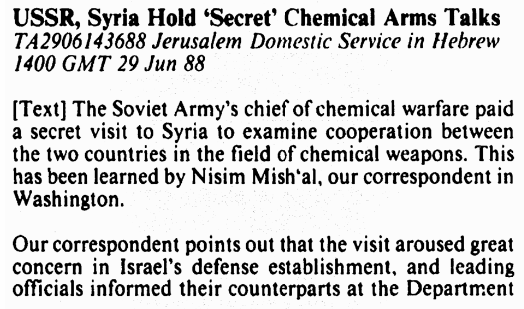
The Soviets denied this relationship. What was not mentioned was that since 1971 Russia had been expanding and modernizing a naval base in the strategic Syrian port of Tartus.
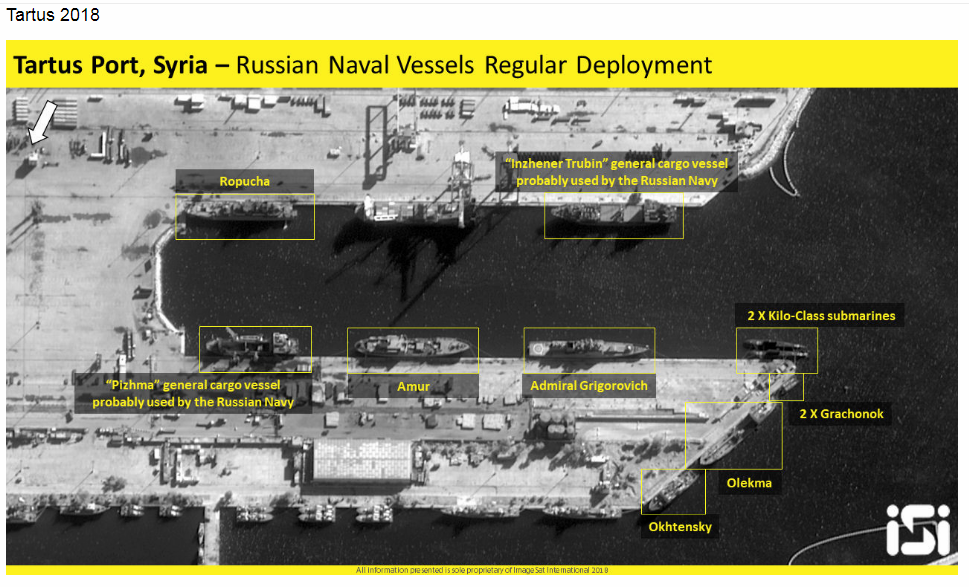
As Russia’s only Mediterranean naval base, Tartus alone would give the Russians an interest in deflecting any criticism of Syria’s military ambitions. Those Scud missiles mentioned earlier? Yes, they originally came from the former Soviet Union. But in its military newspaper Krasnaya Zvezda [Red Star] Moscow was keen to proclaim Soviet innocence of assisting in Assad’s development of Syria’s chemical arsenal:
Not so long ago a claim appeared in the U.S. press about alleged Soviet-Syrian cooperation in the development of chemical weapons. Some Israeli and U.S. officials were cited and the reader was told that with the Soviet Union’s assistance chemical warheads are being produced in Syria for the surface-to-surface missiles in that country. For greater conviction mention was made of the trip to Syria by the USSR Defense Ministry chemical troops chief which, it was claimed, said a lot in itself.
USSR Foreign Ministry spokesmen have stated clearly and unambiguously that this information does not accord with reality. The Soviet Union has never put chemical weapons in foreign hands and has never taught anyone how to produce chemical weapons.
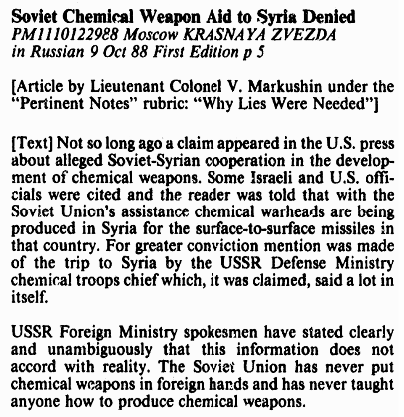
The United States, however, took claims of Syrian chemical agents seriously whatever the source. Similar to today, a military strike was planned. At the time, that concern was heightened by the “explosion of a U.S. airliner” cited in the passage below from the then-official Soviet news agency, TASS. This reference is to the bombing of Pan Am Flight 103 which brought that plane down over Lockerbie, Scotland. Libya subsequently compensated the victims’ families in that case without admitting ultimate responsibility for ordering the bombing.
Washington plans unlawful actions against two sovereign Arab countries, a military strike on Libya and retaliation on Syria, and is whipping up a campaign to justify these actions. Washington expresses “concern” over Libya’s ability to manufacture components of chemical weapons and alleges that Syria is involved in the explosion of a U.S. airliner by “Palestinian terrorists” who, Washington claims, are basing on Syrian territory. The London “STAR” writes that Pentagon experts are working out plans of a raid on Syria, similar to the U.S. raid on Libya in 1986.
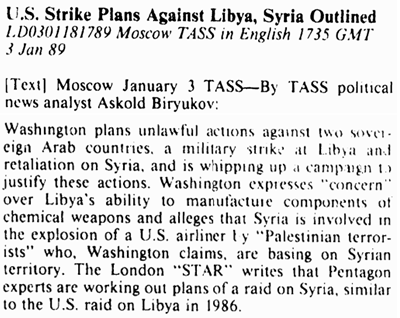
In the following 1992 excerpt from Germany’s Die Zeit [Time], we learn that despite sanctions and air strikes, Syria’s chemical weapons arsenal had only grown since 1986 when Israel first brought it to the world’s attention.
Under, “regarding CERS (Centre des Etudes et de Recherches Scientifiques), Damascus/Syria,” the Pullach spies report on two pages what they found out about the CERS: “The CERS is the biggest economic institution and, at the same time, the leading military research institute in Syria. The CERS is also active in the civilian sphere, but the focus of its task is clearly the field of militarily relevant research and development.”
Therefore, one has to fear for the worst, as is known from experience with similar facilities in Iraq. To prevent any doubts about the intention of CERS, the BND [German Federal Intelligence Service] specifies the objectives of al-Asad’s research workers: Development and production of biological and chemical weapons and agents, missile technology, and microelectronics that can be used for military purposes. In addition, the warning letter says, “The CERS also procures the facilities, equipment, basic materials, and technologies that are required for this purpose.”
It is the first time that German research institutes are warned against specific foreign armament projects.
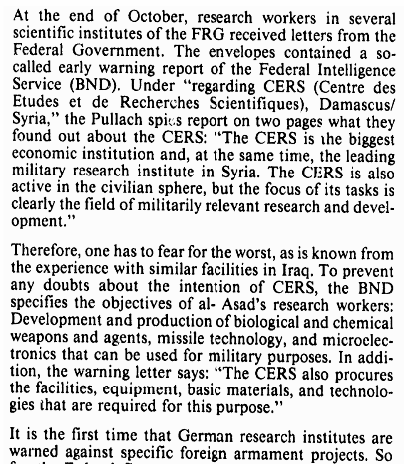
With such widespread and consistent indications of Syria’s long-term interest in chemical weapons, it’s not surprising that the Syrian government would reject any international limitation on that capability. Echoing the Israeli claim with which we began this article, the Syrians cited Israel’s nuclear program as the motivating force behind their quest for parity in WMDs.
It turns out that there is a non-nuclear means of countervailing a nuclear power. Chemical weapons can serve as a more accessible and deniable version of the neutron bomb whose development and deployment was harshly criticized in the 1970s and later, around the time Syria was ramping up its WMD research. Similar to chemical weapons, the neutron bomb has a dire effect on people but leaves physical infrastructure relatively accessible and intact.
Egypt and Syria have reiterated that they will not sign the agreement on chemical weapons until Middle East arms control becomes balanced without exception, particularly in view of Israel’s nuclear armament.
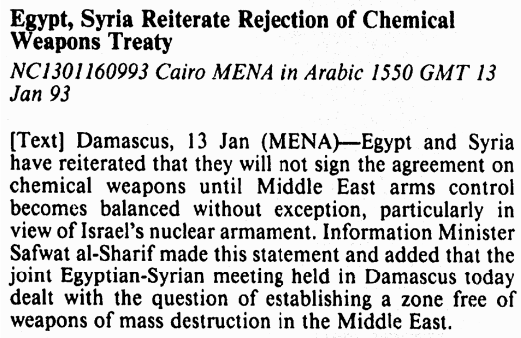
In May 1995, near the end of the time span of Readex’s Nuclear Arms and Weapons of Mass Destruction, Israel attested to the success of the Syrian program:
Today, Syria has the greatest military might in the Arab world in terms of producing and possessing chemical weapons, but is trying to play this down. This was stated in a research paper published today by Dr. Dani Shoham, a researcher at Bar Ilan University’s Begin-al-Sadat Center for Strategic Studies, who specializes in chemical warfare in the Middle East.

Since that report comes from an Israeli source, it might be seen as biased towards that country. As a reality check, here’s an American intelligence analyst quoted in an earlier source based in Damascus:
The Syrians have a no less impressive achievement in the chemical weapons area. “The Syrians have the largest and most sophisticated program in the Arab world in the manufacture of chemical weapons,” American researcher Michael Eisenstadt wrote in JANE’S INTELLIGENCE REVIEW. It makes large quantities of nerve gas (VX and Serin) and mustard gas. Following years long efforts at the Syrian Army’s research and development institute (which parallels our Armament Development Authority) the Syrians managed to develop and manufacture binary chemical warheads for missiles and artillery rockets, as well as air bombs of the same type.

Syria was unapologetic:
The [Syrian] official did not deny the reports in question. He pointed out: “We are in a state of hostility (with Israel), and every people is entitled to possess self-defense means. No one is denouncing Israel’s possession of all types of destructive weapons, nuclear or nonnuclear, or its refusal to sign the nuclear Nonproliferation Treaty.”
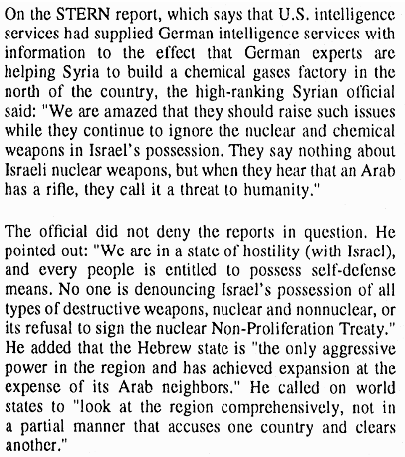
We’ve established that Syria has been developing and stockpiling chemical weapons at least since the early 1980s, assisted by Libya, Russia, and possibly other nations sympathetic to Arab nationalism. In 2013 Syria finally signed the 1993 Convention on the Prohibition of the Development, Production, Stockpiling and Use of Chemical Weapons and on their Destruction.
In that same year U.S. President Barack Obama failed to make good on his “red line” threat to intervene militarily following the use of chemical weapons in Syria. This implicitly validated Syria’s continued use of WMDs, and illustrated the West’s lack of resolve in responding to that use in any but symbolic ways.
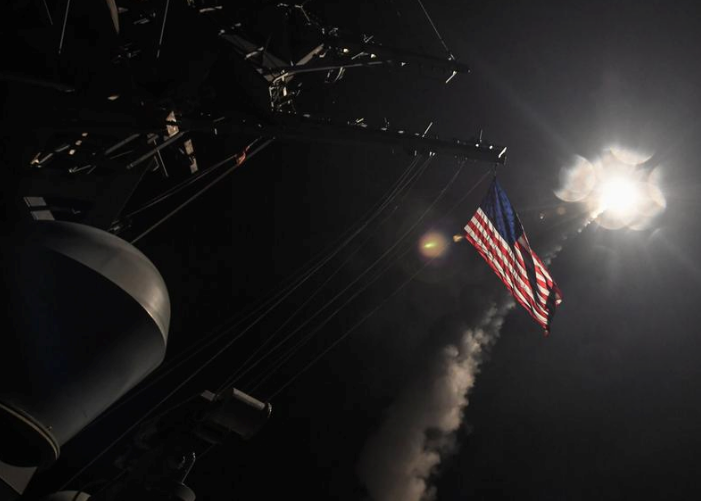
In 2017 the U.S. attacked a Syrian Air Force base following another chemical weapons attack. Now in 2018 the both problem and the response is unchanged, and the Syrian civil war threatens to metastasize into a conflict between the U.S. and Russia. The incentive to develop and use chemical weapons in the region still exists, and the technology is readily available especially for chemicals with legitimate industrial uses such as chlorine.
With fresh evidence that Syria has not abided by their 2013 commitment, the Assad legacy of chemical weapons use is on course to escalate, with no solution in sight so long as the Syrian government is propped up by Russian military assistance and diplomatic roadblocks to change.
We close with President Hafez Assad during a 1992 interview with America’s Time magazine and broadcast on the Syrian Arab Television Network, where he described his nation’s approach to guaranteeing its security in that middle ground between nuclear and conventional arms. In many respects he achieved the balance of power that he passed on to his son; Syria has effectively offset the nuclear potential of those countries aligned against it. What’s more, it’s able to use these deadly means against its own people without any long-term repercussions from the outraged world community.
We are not trying to do anything that we did not do 20 years ago. What we are doing now is something that we have done for the past 20 years. The Israelis know this, and we also know what they have. What we possess now, we possessed 20 years ago. In any event, we are willing to help achieve a breakthrough with regard to weapons in the region provided that a balance is achieved.
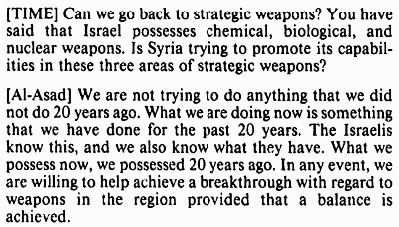
For more information about Readex’s Nuclear Arms and Weapons of Mass Destruction: Global Perspectives, 1945-1996, please contact Readex Marketing.



